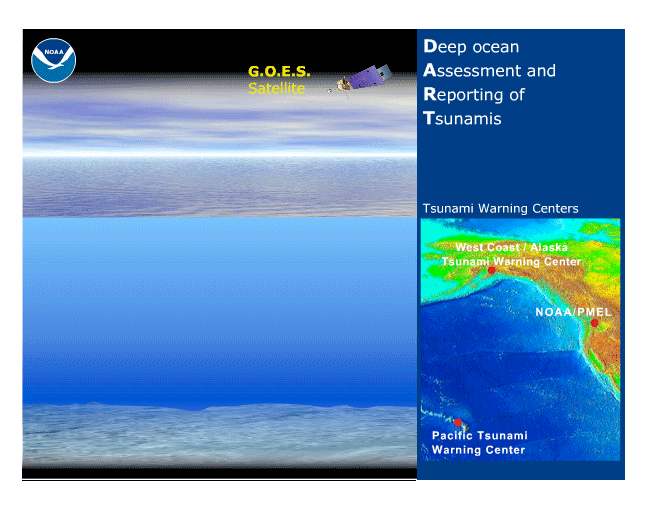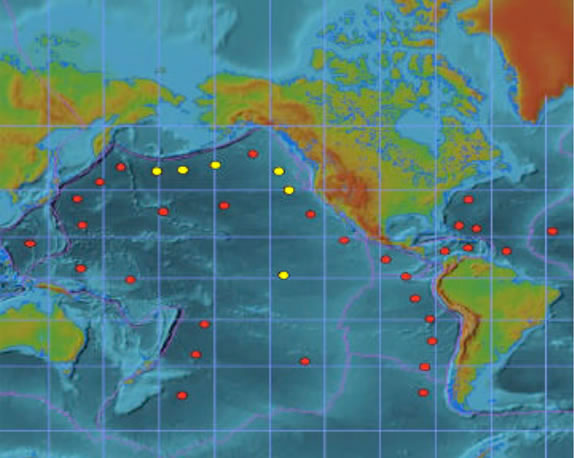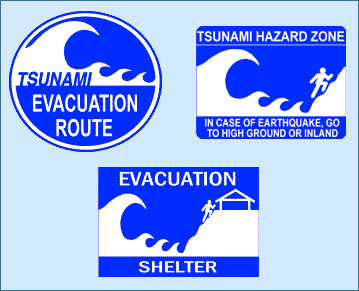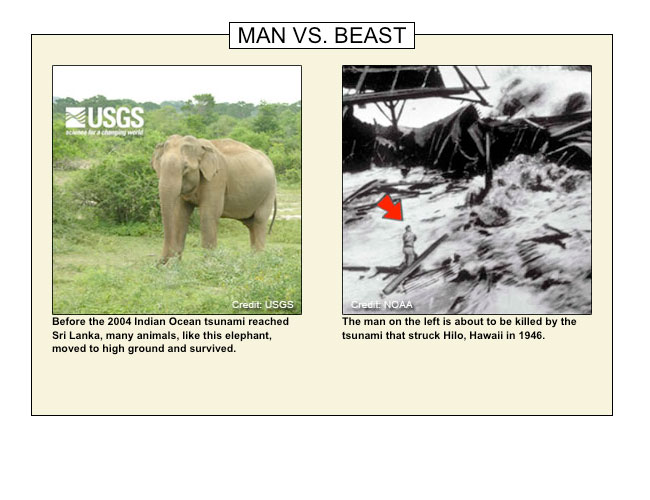Tsunami Warning System
A tsunami is a series of large waves generated by the sudden displacement of water during an earthquake, landslide, volcanic eruption, or meteorite impact. Tsunami can cause incredible destruction to coastal communities, crushing structures under their enormous weight, and quickly drowning man and beast or sweeping them away to perish at sea.
The death toll of a tsunami could be greatly reduced if coastal communities could be warned of its approach. In this activity, you will explore different warning signs and systems, and learn how to respond to an approaching tsunami.
Instructions: Read the articles and then scroll down to answer the questions that follow.
Questions
- Apparently, some animals are alerted to the approach of a large tsunami in ways that humans can’t detect. Speculate about what warning signs animals might pick up that people cannot.
[Check Answer]
Animals tend to pay more attention to their environment than people do, and many have more acute senses, especially of hearing. The animals may actually have heard the earthquake strike – quakes generate very low frequency sound waves, below the range of human hearing but within the ranges of many animals. The earthquake would have caused the ground to vibrate thousands of miles away. These vibrations may have been too subtle for humans to notice as they went about their daily lives, but were picked up by animals.
- Describe several warning signs that often precede tsunami.
[Check Answer]
Anyone close enough to the start of a tsunami will feel the earthquake and see or hear the volcanic eruption that starts one. Tsunami can pull water away from the beach as the get close to shore, causing a sudden drop in sea level. Large numbers of animals may run away from the shore or act oddly. Tsunami are actually a series of waves (and the first one isn’t usually the biggest), so the arrival of a really big wave may mean there are worse to come.
- Why do you think so many people ignore these indicators?
[Check Answer]
The biggest reason is probably ignorance. Tsunami are rare, and many people know little or nothing about them. December 26, 2004 may have been the first time many people had even heard the word. If you had never heard that these killer waves often cause the ocean to pull away from the beach, you might easily be drawn toward such a sight by curiosity. Many people who survived the first wave may have gone to the shore to help others or check on their property, not knowing that a tsunami can be multiple waves spaced many minutes to 1 or 2 hours apart.
- If you detect any tsunami warning signs, what should you do?
[Check Answer]
The best response is to move quickly and immediately inland and to high ground. If you don’t have time to get away from the shore, you should get to the upper floors of buildings or climb sturdy trees. You should stay away from the shore for several hours after the first wave hits.
Government Tsunami Warning Systems
The National Oceanographic and Atmospheric Administration has deployed a series of Deep Ocean Assessment and Reporting of Tsunami (DART) buoys in the Pacific Ocean as part of their system to detect the deadly waves.
Instructions: Review the animation and images below and then scroll down to answer the questions that follow.

Sensors on the sea floor relay suspicious pressure changes to a surface buoy, which sends the data to NOAA’s tsunami warning centers. Scientists analyze the information, and issue tsunami alerts to authorities in threatened areas.

Yellow dots mark the location of existing DART buoys. Red dots are buoys proposed for an expanded tsunami monitoring system.

Many Pacific coast communities have developed tsunami educational programs and emergency plans.
Questions
- There are a lot of waves in the ocean – how can the DART sensors tell the difference between an ordinary wave and a tsunami?
[Check Answer]
Ordinary wind waves disturb only a very thin layer of water at the surface of the sea, and so don’t affect the sea floor far, far below. Tsunami move the entire water column, which in the open sea is thousands of meters thick. So when a tsunami rolls over a sensor on the sea floor, it will cause a noticeable change in water pressure.
- Why do you think NOAA’s DART buoys were originally placed just in the north and central Pacific? Suggest some geologic and political reasons for the planned expansion of the system and the placement of the extra buoys.
[Check Answer]
The Pacific Ocean is the site of violent geologic events. Its edge is called the Ring of Fire, because it is lined by active volcanoes. Strong earthquakes are common. All this tectonic activity makes tsunami more frequent in the Pacific than in the Atlantic. And countries on the North Pacific rim, like the United States and Japan, had the financial and technological means to develop, install, and maintain a system of warning buoys.
Since these sensors were put in place, geologists have learned that the east coast is also vulnerable to tsunami, mainly due to enormous undersea landslides. And the 2004 event made it clear that the humanitarian and financial costs of tsunami in other parts of the world justify expanding the system to cover even those countries that cannot pay to participate.
- The tsunami warning buoy system was established to help give people time to evacuate before a tsunami strikes. But are these warnings always going to come in time? Explain.
[Check Answer]
Some people will not be warned in time to evacuate. In the current NOAA Tsunami Early Warning System, sensors must register an earthquake or change in water pressure and alert the warning centers, then scientists have to study the data, determine who is at risk, and notify the authorities, and then officials warn the public. All this takes time. But people closest to the source of a tsunami may be hit only a few minutes after the earthquake or eruption, long before warnings can be issued.
Critical Thinking
Tsunami prediction is complicated by a number of scientific uncertainties. For example, the formation and behavior of a tsunami caused by an underwater earthquake depends upon the size of the quake, the speed and direction of earth movement, the shape and depth of the ocean basin, the orientation and slope of coastlines, and so on. Despite the challenges of predicting tsunami, many scientists who do so think they have the easy job – the harder task falls on the local authorities who must get their citizens to safety. What are some of the problems of warning the public and getting them to evacuate ahead of a tsunami?Evacuations are expensive and incredibly disruptive. Government officials have a difficult choice – if they order one and a tsunami doesn’t hit, people will be furious and may not react to the next warning, but if they don’t order an evacuation and a tsunami strikes, people die. Once an evacuation begins, there are logistical problems – in crowded, urban areas the roads may not be able to handle the crowds, and in poor areas many people may not have access to rapid transportation. It may be difficult to reach many of the people in danger. For example, beachgoers and boaters may not be listening to radio or television. There are also psychological barriers – some people will panic and disrupt an orderly, efficient evacuation. Many will be confused about what to do and where to go. Others will not take the warning seriously or will refuse to leave their homes or businesses.
Related Links
Multimedia Discovery Missions: Lesson 9 - Ocean Waves


